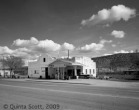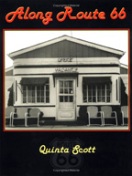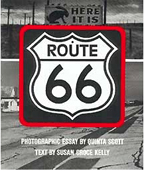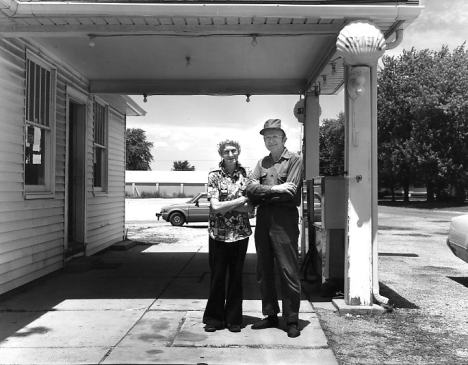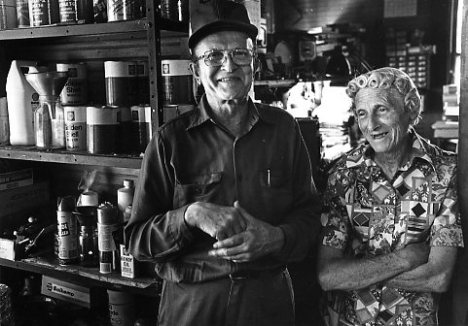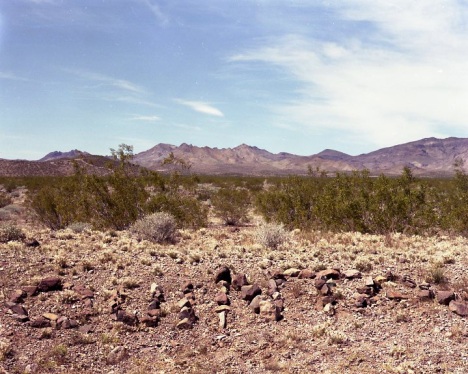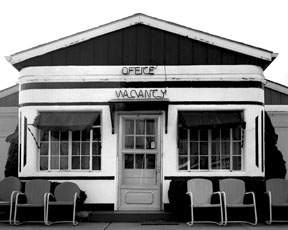Daio Hoffman asked on the Route 66 site on Linked-in if there is a place on Route 66 that most symbolizes the Mother Road.
There is: the State of Oklahoma. When the Joads and the Okies were fleeing west to California to escape the Dust Bowl, people like Ann and Leon Little migrated to Route 66, pumped gas, and served burgers to the people going west. This happened over and over in Oklahoma.
From Along Route 66:
“Ann and Leon Little made a good living on this stretch of highway west of El Reno. When they married in 1932, they bought an old gas station next to the Swinging Bridge on 66 at Bridgeport. In 1934 when the new bridge over the South Canadian was completed several miles south of Bridgeport, the Littles built a new station at the west end of the bridge at the intersection of U.S. 66 and U.S. 281. They called the place Hinton Junction. Six years later they expanded their business and built a third station, a cafe, and motel west of the junction. Little laid up walls of structural clay tile which he protected with stucco. He whitewashed the imposing two-story gas station and residence–razed before 1981–and the boxey cafe, but Oklahoma dust soon turned the buildings pink. The eight room motel was a long, low ranch-style bungalow set on the back of the property. When Leon was drafted in 1943, he leased the business to E.B. Enze who closed down Leon’s complex, and opened his own business in a new stucco building at the intersection of 66 and 281. When Leon returned from the war, he and Ann had to start over.”
Ann described serving a meal during the Dust Bowl. She set the meal on the table, and drew the corners of the table cloth over the meal to protect it from the dust. When Leon came in from building the new gas station, she carefully, folded the corners back to keep the dust from falling into the food.
Ann and Leon did so well after World War II, when Americans started traveling for fun, that they were able to send their kids to college and retire to a nice ranch house in Hinton, when I-40 opened and replaced 66 through Oklahoma.
Down the road from the Littles’ place was Bridgeport, actually new Bridgeport. From Along Route 66:
“Before 1934 Harvey Wornstaff ran a gas station at the east end of the Swinging Bridge at Bridgeport. When the Oklahoma Highway Department rerouted 66 across the new bridge, the citizens of Bridgeport got in a dispute about the future of their town. Bridgeport had no future. The fight ended in a draw. Half the town moved to Hinton; the other half to new 66 where they established a roadside stringtown they named Bridgeport. It stretched for a mile along 66, all little gas stations, motels, cafes, food stands, and a dance hall. Dale Lee had a gas station and repair shop; Jack Hind a gas station and hamburger stand; Velma and Ray Yount a gas station and lunch room; Nancy Rose a grocery with pumps; Happy Jack the dance hall, and so on, all competing for the dollars that came down 66. Harvey Wornstaff had a gas station, restaurant, and motel. He named it after himself, and housed the restaurant, the gas station, and his living quarters in the low stucco building. To the east, he built little square cabins for overnight guests. What was left of old Bridgeport? A grocery, an old hotel converted to apartments, the post office, and the telephone office–that was it; the rest just disappeared as did new Bridgeport after the interstate replaced 66 in 1962.”
When you travel U.S. 66 in Oklahoma, don’t ignore all those broken down stucco buildings that date back to the 1930s. They are the real 66 and the people who lived and worked in them made their livings from the people who migrated west during the Dust Bowl and thrived after World War II and during the 1950s.
Visit AlongRoute66.com is see more photographs of the old highway in Oklahoma.
Filed under: Fine Art Photography, Old Old Route 66 | 1 Comment »


